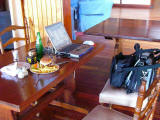
Lunch and temporary computer workplace
Private homepage – Hans-Georg Michna
Kenya travel reports: 1999, 2000, 2002, 2003, 2004, 2005, 2006, 2007, 2008, 2009, 2010, 2011, 2012, 2013-Goma, 2013, 2014, 2015, 2016, 2017, 2018, 2019
Kenya Safari Travel Plan, Kenya 1980-2000 photos
Kenya 2009
A personal travel report from Kenya in May 2009
Last change: 2009-06-06 Copyright 2009-2023 Hans-Georg Michna
Click on the small pictures to see them enlarged, usually to 800 x 600 pixels.
Times are given in local Kenyan time in 24h format (without "am" or "pm"), i.e. 0:00 to 23:59
A few readers had the problem that after clicking on a picture, then going back to the main page, all thumbnail pictures were reloaded. This is typically caused by Internet Explorer cache corruption. It can often be repaired by going to the Internet options and deleting the temporary Internet files.
All photos are subject to copyright . If you want to reuse any photo, send me an email asking for permission, and I may send you the full-size photo, usually 1,600 x 1,200 pixels. Photos bear the copyright 2009-2023 Hans-Georg Michna.
EXIF times in the pictures are UTC; add 3 hours to get Kenya time.
[Still the same cameramy Panasonic Lumix DMC-FZ1-2 digital camera. Most photographs in this travel report are reduced to 800 x 600 pixels and JPEG-compressed with medium strength to make them more palatable for the web.]
Table of contents
Echo, the most well-known and famous wild elephant, matriarch of her family group for many years, and the star of a number of documentary movies, has died in Amboseli while I flew in. The probable cause was her age, probably 64, combined with the dryness of the last three years.
She will be missed by her family and by everybody who knew about her, particularly by Dr. Cynthia J. Moss, the researcher who knew her best. Echo was an outstanding leader of her family group, which grew from 7 to 38 individuals under her guidance.
| Departure | Arrival | Flight | Status |
|---|---|---|---|
| 06:50 Sun 03 May, Munich | 08:25 Sun 03 May, Amsterdam | KL 1790 | Flown |
| 10:15 Sun 03 May, Amsterdam | 19:05 Sun 03 May, Nairobi | KL 0565 | Flown |
| 08:40 Sun 31 May, Nairobi | 16:30 Sun 31 May, Amsterdam | KL 4140 | Flown |
| 18:15 Sun 31 May, Amsterdam | 19:45 Sun 31 May, Munich | KL 1799 | Flown |
My travelling checklist in michna.com/kenya.htm#Preparations (German version michna.com/kenia.htm#Reisevorbereitungen) is, as always, my means of packing without fear of forgetting anything important.
KLM and Kenya Airways on their flights to Nairobi currently allow two pieces of baggage of up to 23 kg each in the economy class.
Yesterday I packed my bags. Due to KLM's piece concept on the Kenya flights I can take an extra bag or suitcase with clothes as gifts.
They also have online check-in from 24 hours to 2 hours before departure, and they even send a reminder email. I could even change my seat, but only for the flight from Munich to Amsterdam. For the long flight the system did not work and only produced an error message. However, I believe I had once given them my general preference for window seats, and the seat I got (30K) is about the one I wanted.
They also send me information about delays, gate changes, cancellations, and boarding time by SMS to my mobile phone.
This morning I woke up at 4 am and drove to the airport, partly at 200 km/h, which would be the last time for the next four weeks when I could drive any speeds like that. In Kenya driving above 100 km/h is usually too dangerous and would require certain rare conditions, even if it were legal, like no bushes next to the road, from which goats can run out, no potholes.
KLM has a new check-in system where you do the check-in yourself, but I had done that already on their web site. The counters are still there, but they don't do the check-in. They are now merely called "baggage drop-off". I think this is very good, because it seems to speed up the process quite a bit.
The flight was uneventful and altogether OK. I didn't get a real window seat though. The plane turned out to be a Jumbo (Boeing 747-400), and seat 30K was (a) directly over the wing root and (b) apparently inside a major fuselage rib holding the wings, so there was no window exactly at that point. Well, bad luck, but not really important. I couldn't record the complete route though. It cut through Egypt and Ethiopia.
I arrived on time, my luggage as well. I have also learned the trick to bypass the waiting lines at the visa counters and went straight to the other ones on the left side, where the wait was much shorter. This way I came down to the luggage belt just when my big, yellow bag with gifts was coming. My more important personal bag came later, but it came.
The visa fees have been lowered. A visa now costs 20 or US$25.
There is a new customs form where one has to declare certain things for customs, bringing the total number of forms to be filled to three, along with the immigration card and the visa application form. All three were given out on the flight already, so I could fill them before landing.
I pulled as much Kenyan cash as possible (KSh 40,000, about 400) from the Barclays ATM on the airport, then took a taxi to Rasuls, where I switched over to my little four-wheel-drive vehicle, the same one I have driven before, a Suzuki Maruti Gypsy. The car is in good shape and works very well.
When I drove out into the dark street, I had to remind myself once that I now have to drive on the left side, but since then the driving came naturally, as if I had never driven any other car or on any other side before. I felt right at home and was a little bit surprised by that.
I loaded the luggage from the taxi to the off-roader and set off. I briefly stopped to mount my GPS, which makes driving in the dark a tad easier. Then I drove on across the nightly Nairobi towards Wilson Airport and the Aero Club of East Africa, more or less my home here.
The bartender had kept the room key for me. I chatted a little bit with him, then went to my room and slept early and long.
I woke up at early dawn, mainly from the exotic sound of the birds. In Africa all life seems to be more intense, perhaps because of the higher energy throughput from the sun. Plants grow faster, there are more animals and more species. There are more different bird songs, and they sing more intensely as well.
The first thing I did was to walk over to the CJ Aviation office to look for the aeroplane I had planned to use later. It was out, but will come back tonight, and I made an appointment for a checkout flight for tomorrow, 11 am. A short time later I met the checkout pilot and chatted with him briefly.
After a little breakfast, toast and Kenyan tea, boiled in milk and usually taken with sugar, I drove to the doctor who does the medical exams required for the pilot license and got a quick appointment one hour later. I decided to use this hour to drive to Rasuls' office and workshop downtown to collect a tow rope and finalize the rental contract. There I met three generations of the family at once and got everything I needed. That left me about 25 minutes to drive back the few kilometers to the doctor.
But I made the mistake of turning into Uhuru Highway, the six-lane backbone of Nairobi. Only a few meters after driving into it, the traffic stopped, and I was stuck in a big traffic jam that lasted until the next roundabout and took most of the 25 minutes I had.
I turned off and used an excellent little road up along the eastern Nairobil hillside that apparently most drivers don't know. After 27 minutes I reached the doctor's office. I would have been faster on a bicycle.
The examination was uneventful, and half an hour later I had the medical.
On my way into Wilson Airport I stopped at a mobile phone shop and bought two SIM cards, one for Safaricom, the other for ZAIN. These are the two mobile phone networks in Kenya.
Now I'm sitting in the Aero Club's restaurant at the table that has an electric socket, so I can run my old little laptop, write this travel report, and try out the two different mobile phone networks. One of them is the already tested Safaricom, the other has changed its name from KenCell to CelTel and now to ZAIN. I have to test this new one, because Safaricom has good coverage, but its connection quality is often poor. There is always hope that the other one may be better.
When I wanted to check my email, I noticed that the IMAP folders were not synchronized, so I'm doing that now in the background, while I'm working on other things. This will take a few hours because of the slow connection, but I have to do it before I can use my email.
It had rained recently, but I have not seen any rain yet. Temperatures are cool, say the Kenyans, but at the current 25C in the early afternoon I left my summer jacket in my room, because for me this is still warm. Moreover, the moisture is relatively high for Nairobi. It is partly cloudy with occasional sunshine. Coming from Germany I perceive this as quite similar to a typical and nice German summer.
As soon as the rains die down, the air will become drier here and the temperatures may rise a bit more, but Nairobi at 1,600 m (5,500 ft) is too high to get very hot.
My lunch just came.

Lunch and temporary computer workplace
While I was eating, Colin Davies happened to pass by, the owner of the company from which I rent the aeroplane. He told me a frightening story about his Cessna 206, which was destroyed in a very unusual way. One of the three propeller blades tore off during cruising flight, and the centrifugal forces tore off three of the four bolts that hold the engine in place in the few seconds before the pilot could shut the engine down.
The experienced pilot did an emergency landing and survived unharmed. There was an engine fire, but he could extinguish that too. In fact, no further damage to the aeroplane was done in the landing, but the aeroplane's frame was severely damaged by the attempt of the engine to tear itself out. The plane needs to be rebuilt completely, something which few people can do as well as Colin and his crew of aeroplane mechanics.
A propeller breaking without any previous, visible signs of damage is a very rare occurrence. It seems that there was some internal flaw in the metal that ultimately led to the sudden break. In fact, purely technical failures are already somewhat rare even in small aeroplanes. The thing that fails much more often is the pilot's brain.
Forget about the rest of the day. I spent it on analyzing and fixing a nasty problem in my computer that prevented the Internet connection through my mobile phone. It turned out to be a Windows problem, probably caused by automatic updates. (Bluetooth service had insufficient access rights.) It took far too many hours to find and fix this. But without a mobile Internet connection I wouldn't be able to update this travel report while away from Nairobi, among other things like email.
Today was another very busy day. I don't want to bore you with the details, apart from stating that I could not get the ZAIN mobile phone Internet connection to work, while the similar Safaricom Internet connection worked on the spot (apart from my abovementioned problem, but that had nothing to do with the provider). I made three calls to the ZAIN customer support hotline, got three totally different answers, all of which were wrong. They were progressively getting better, and the third one actually yielded a service message with settings, but those settings were for web and for MMS services, not for an Internet connection. Guess I have to give up on that provider. One of the killer criteria is that they openly state that they need 24 hours to activate GPRS service, which is a joke.
The more interesting event was the checkout flight. I had not previously flown this aircraft or any straight Cessna 172 in Kenya. This one, named 5Y-BUU, is already a newer one with 160 hp, which provides a payload of 260 kg with full tanks. This means that it is not a real four-seater like the much stronger Cessna 182, but it does carry three people with some luggage, provided the people are not too heavy.
A checkout flight is done because the owner of the plane wants to make sure that I can fly the aeroplane safely.
The Cessna 172 feels lighter and more responsive than the heavier Cessna 182 and is delightful to fly. I'm looking forward to the flight to Lamu I will do with this aeroplane.
In the early evening I met a new member of the Somali Network, Fatma. She works as a newscaster for a local radio station and is a very nice person. She will join the flight to Lamu.
On the way back I found that she lives just around the corner, in short walking distance from the house in which I lived during my first years in Kenya.
Back in my Aero Club room I found that I have a co-inhabitant in my rooma little gecko. Maybe I don't need to use the mosquito net tonight.
Rasuls' junior boss had offered to book me into a fine lodge in Tsavo East National Park, which I had never visited before. Yesterday I called him and asked him about that offer, and he did it. Now I'm booked at a favorable all-inclusive price into the Voi Wildlife Lodge and am driving there today. This takes me down almost two thirds of the Mombasa Road and down from an altitude of 1,600 m (5,500 ft) to only 600 m (2,000 ft). The climate is accordingly warmer. I have rolled up my sleeves. Some photos of the Mombasa Road:
Along the road I drove through two tiny rainshowers with a few drops and a big one just before Voi, where I had to close the windows and switch the windshield wiper to max. The rainy season is definitely not over yet, but the lower temperatures even in a warm place like Voi may be worth a few rainshowers for me.
The lodge is luxurious. My room has two Lamu-style double beds, a spacious balcony behind a glass door and an additional insect screen door that span almost the whole width of the room, lots of space for luggage, a fan, and, of course, a bathroom with shower.
From the balcony I oversee the waterhole, which is currently visited by 27 elephants and a waterbuck. Vervet monkeys are also moving past my balcony, so I don't want to leave the glass door open when I'm not here.
The price is hard to believeKSh4,000 full board, not much more than 40 per nightfor which you probably couldn't find even a normal hotel room with breakfast in Germany. I got a special discount, because the owner of the lodge is a relation of Rasuls, but even the full price would be quite good.
It was already too late to squeeze in a game drive, so I just watched the elephants from my balcony and went to dinner after dark. The dinner room is an open-air arrangement facing the waterhole and the wilderness around it. Meanwhile a buffalo herd had come to the waterhole.
I had not even finished my soup when a group of lions appeared and moved around between the waterhole and the lodge, i.e. very near. For my first evening out in the bush during this trip I think I already set the stakes very high.
While I ate the next dinner courses, the elephants watched silently, and the buffalos moved away. Three of the lions followed them slowly.
I went back to my room and am now writing this, while listening to the roaring lions and the elephants, who are meanwhile a bit upset with lions so close by. I keep hearing them trumpet from time to time. With my balcony doors wide open and only the insect screens closed, I will keep listening to the sounds of the African night until I will fall asleep.
I woke up at sunrise and drove out for an early-morning game drive. Even before I reached the gate of the nature reserve, I met a small group of buffalos with at least one very young calf. Perhaps there were more in the bush, but I could not see very far in the bushy area.
While I was watching the buffalos move, I noticed that they were being followed by a pride of lions.

Lioness on an early-morning hunt
The lions were spreading out and slowly following the buffalos. They may have been watching out for a good opportunity to separate one buffalo from the herd, particularly a young calf, which would then be easy to catch.
Slowly the buffalos moved further and further, and the lions kept following them into the bush and disappeared from my view, so I continued my first drive deeper into the nature reserve.
I stopped for two giraffes next to the track, did not want to scare them away, and then for a group of elephants that were feeding along my track and moving towards me. When I saw them and stopped, they were already quite close, not much more than 20 m, but they were obviously not disturbed and continued feeding despite my close proximity. (No photo, because I was driving towards the rising sun with the attendant poor lighting.) They looked good, and most had long tusks. One of them had them crossed just like Echo's, reminding me of Echo's death again.
I backed up twice, because I didn't want them to change their direction just because of an obnoxious tourist car, but then they crossed the track and slowly moved away. I pondered the thought whether they understand that cars have to stay on the track and move away from the track to let them pass. In some areas with many tourist cars I sometimes see cars passing right next to elephants at a distance of only very few meters, while the elephants look up and take notice, but do not move. I never do that intentionally, but may have done it unknowingly, because it is easy to overlook even a very big animal in the bush, even at a very short distance.
Tsavo East is huge. The bigger, northern part used to be closed, but even the smaller part south of the Galana River is so big that I had no chance of reaching the river on a short morning game drive and getting back in time for breakfast, which this lodge offers up to 9:30. So I went as far as I could towards the East, then turned back and had a nice breakfast with scrambled eggs, pancakes, pineapple, Passion fruit juice, and finally tea. Then I went to my room for my first opportunity to do nothing, at least for a short while. Later I began to write.
While I am writing this, a group of elephants passes by my balcony and moves to the waterhole.
While walking to my car after lunch I took these photographs of a Hindu temple in the lodge:

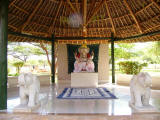
Temple for the Hindu god Ganesh in the lodge
Then I drove out to check the southeastern corner of the park, but I could not get through. The first track I tried was blocked by two private tented lodges, and on the second I actually got stuck in a dry river crossing. In fact I had already crossed the river, but then got stuck on the other side, just 1 m before being on straight and firm soil again, in a little diagonal gully. I got stuck because this little four-wheel-drive vehicle does not have a differential lock in the main differential between front and rear axles. The front left and rear right wheels were more or less hanging in the air and slipped, so the other two wheels got no torque.
I had already dug the car free when a tourist bus appeared, and the driver and one passenger offered to help by pushing. I told them this was probably not necessary and I wouldn't like to take their time, but they insisted, and with two people pushing backwards, four-wheel drive engaged, and the wheels already dug out, the car moved back down instantly and without any further problem.
I didn't try a second time to pass the obstacle, particularly because it was already fairly late, and I might have had to go back the same difficult way if other ways proved similarly difficult. So I turned back. The tourist bus, of course, had no intention and no chance to cross the river here. These minibusses have only two-wheel drive and no off-road tires.
On my way I found a wonderful little camp site with several stone tables and benches and even a little stone building with showers, flush toilets, and a water container on the roof, but it was disused, and nothing worked any more. What a pity!
I saw a wide range of wild animals, particularly lots of elephants. One young elephant bull stood behind a bush, such that I could see him only when I was already within a few meters. I slammed on the brakes and stood before him, and he eyed me nervously too. I thought for a moment that he might be self-assured enough to attack and poke his tusks through my car, but after a second or two he had decided to back off and retreat to the rest of his family.
Back in the lodge just after sunset, a nice, but far too big dinner rounded out the day. When I didn't finish the courses, the waitress was seriously worried that I didn't like the food, but I could explain that it had just been too much.
Today I drove north through the nature reserve to reach and drive along the Galana River for some distance. This meant I would miss breakfast, but I didn't consider that much of a problem after all the hefty recent meals.
I set out at sunrise and found once more that Tsavo East is big. Considering that I only covered the smaller southern part of it, south of the Galana River, this means that the whole of the nature reserve is really huge. Even though I drove much of the way at over 60 km/h, it took me over an hour to reach the river.
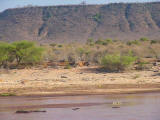
Galana River and Yatta Escarpment
Not far from the place where I met the river there is a crossing. I crossed the river briefly and returned, just for the fun of it. On both sides of the crossing there were hippos in the water. They were so close that I pondered the thought for a moment that they could attack me.
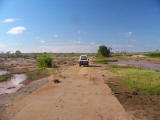
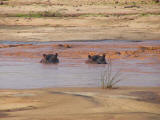
Crossing Galana River; hippos guarding the river crossing
Galana looks like a big river, but the amount of water was currently not very high. Where the river is wide, it is also very shallow.
I first explored a westerly stretch, then returned and drove downstream, to the east.
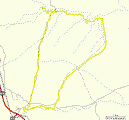
GPS track of Galana River trip
Finally I returned to the area near Voi Gate and did a final game drive there, but in the heat of the day, my expectations were rightfully not high.
The whole Galana River trip did not yield many wildlife sightings. The area I crossed is rather barren. I termed it, "Land of the termites". In some areas with little sidearms of the main river I saw some waterbucks and buffalos, but they were not very used to what little car traffic exists there and were shy.
I drove back to the lodge for lunch and ate, particularly since I hadn't had any breakfast today.
Afterwards I dozed in my room, and when I came back to my senses, it was already 17:30. I thought for a moment, then decided to do a final, short game drive.
This turned out to have been a good decision, because I had several unique sights that evening. The first was the largest herd of buffalos I have ever seen, an estimated 2,000 animals. When I drove into the Voi River valley, they were all walking toward me, and the last ones were stampeding down a hillslope in a cloud of dust. Unfortunately I was stunned for just too long to take a photograph of this surprise scene.
The reason was that they were followed by lions, of which I could photograph one later.
After the buffalos came to rest in the river valley, I drove on and found three cheetahs, a mother and two nearly adult cubs.
One lioness laid next to the track, thus blocking my way. I had to wait for a while, until I could estimate her reactions better, then I slowly passed her on the far side of the track. She looked at me and bared her teeth for a moment, but didn't move. This was so far the shortest, but also the most interesting game drive.
Since this one couldn't be topped, I decided to spend the next day off in the lodge for sleeping, resting, telephoning, emailing, writing, planning, and generally being lazy.
On that day I met a couple of Indian origin, Mulji and Pushpa Ratna, and we started talking. It turned out that these were not only the owners, but that Mulji Ratna was also the builder of this wonderful lodge, as well as the builder of Petley's Inn in Lamu and several other significant buildings around Kenya.
The next day I drove back to Nairobi to meet friends.
In the morning I drove out of Nairobi on Limuru Road, which may be the highest route into the Great Rift Valley. In the morning sun I reached the edge of the Rift Valley and drove down, or coasted down, to Mai Mahiu, deep down on the bottom of the valley and with a great view on the volcanos Mt. Longonot and Mt. Suswa.
In the photo you look towards north-northwest, and you can see on the horizon the edge of the Rift Valley on the right side and the volcano Mt. Longonot on the left. You can see a piece of the road I am driving down at the right edge. This road lets me climb down to the bottom of the Rift Valley. In the center you can see Mai Mahiu.
In the saddle between Mt. Longonot and the Rift Valley edge you can see the road continuing straight to Naivasha. From the center of Mai Mahiu you can recognize a piece of the road, and houses alongside that road, leading to the left. That is the road across the Rift Valley that I am going to take towards Narok and Masai Mara.
And so I did. In Mai Mahiu I left the road leading north towards Naivasha and Nakuru and turned left, to the west and towards the Suswa volcano to cross the Rift Valley. To my joy it turned out that the road works I had seen last year are now almost finalized, and almost all of the road to Narok is now new and nearly first class. This shaves at least an hour off the driving time and makes the trip, which used to be tedious and nerve-racking, now pleasant, easy, and fast. Of course there are still a few places with work in progress, but they are few and far between.
After a little lunch at the Kenol petrol station in Narok I reached Sekenani Gate, the main entrance to Masai Mara, already in the early afternoon, such that I had a lot of time to drive through the wonderful nature reserve with its incredible wealth of large and small mammals and birds and could still arrive at my favorite lodge, Fig Tree Camp, well in time before dark.
It had rained and was still raining a little bit during part of my drive, and in some places the soil was slippery. I took the precaution to engage the front wheel axle locks, just in case I would need the four-wheel drive, but I never actually used it.
I drove past a large herd of buffalos and stopped for a while to watch them. The I continued past several herds of different antelope and gazelle species and zebras, a group of giraffes including a few quite young ones, two hyaenas, and several birds of prey.
Before reaching the lodge I turned off and drove a detour past more herds and a bunch of warthogs.
The grass was conspicuously short for most of my drive. Usually after the rainy season the grass is high in most areas, and only a few places are grazed down. This year seems to be different, probably because of the late and insufficient rains.
Finally I drove to the lodge. The parking lot was empty. No tourists! It turned out that there were actually two couples besides me, who were still on a game drive. So the lodge, which can accommodate perhaps hundred people, was hosting five.
The way from the parking lot to the lodge leads across Talek River over a footbridge with a thatched roof. Before I could enter the footbridge, a whole flock of striped mongoose (German: Zebra-Manguste) came out. They had discovered the bridge and used it to their advantage, as they would never dare to swim across a river on their daily forays for food.
The cooking seems to have improved. The food was quite good. Then, after a cup of tea, I went to my tent to answer emails and write this to the sound of the hunting hyaenas on the other side of Talek River.
Today is a gray day, quite unusual for Masai Mara and for Kenya in general. So far there has been almost no sunshine at all.
I still drove out in the morning and admired the herds of ungulates and 4 hyaenas, one of them collared and thus monitored by the hyaena research project. The "black cotton soil" is wet, and I got stuck once, but could get out by just letting the wheels dig through to firm ground, create a little runway by repeatedly going forward and back, then drive out with some momentum. I cannot drive in the very low areas next to the river, because that's where the rainwater ran to and where it is now very wet, and some horizontal areas or depressions are also unpassable. But this is not a serious problem, as many of the tracks are drivable. The lack of good photo lighting is a bit unfortunate.
Drove out again in the evening for more wildlife watching. Conditions unchanged. It was, as always, interesting, but yielded no photos.
It rained during the second half of the night, and when I drove out this morning, I could only stay on the main, stony tracks. I tried to drive into a track on the grassland once, almost got stuck after the first three meters, drove on for about 30 m, then turned back, because it was to wet and muddy. The tracks here look sandy and dry, but under the millimeter of sand the have a layer of the already mentioned black cotton soil that soaks up moisture. After a longer rain, this mud layer can be deep enough for a car tire to sink in to the rim, and then it is difficult to get out again.
So I drove along the main tracks for a while in the beautiful morning sun, looked at the gazelles, antelopes, and warthogs and enjoyed the beauty of the landscape.
I did see large herds of Maasai cattle again, which reminded me of the sad truth that the last bits of primeval African nature are under permanent siege from all sides. I cannot help but mention that here, if only to remind you to go and see some of these places while they still exist.
In the photo you can see what a swathe of former grassland looks like after a herd of Maasai cattle trampled over it when the soil was wet. I have taken this photo not in some remote place that few people see, but right across the way that all tourists take when they drive from Fig Tree Camp deeper into the nature reserve, about 300 m from the camp.
Some other, possibly even weightier effects of cattle grazing in nature reserves are that the grass that would otherwise feed wild animals is now eaten off to the ground, so the wild animals have to move somewhere else. Indeed the herds of gazelles and antelopes were smaller this year than they used to be.
Another effect is that the large predators move away, particularly lions and cheetahs. While I have almost always seen some in this place, I haven't seen any this year yet.
For me the sad story is that people don't seem to realize that the spots of primeval nature we still have are very few and rapidly shrinking. There are hardly any left in southern Africa, where nature is managed by creating artificial boreholes for water, by culling elephants, etc. What you can see there is indeed some wild animals, but they live in an artificial vegetation mix that doesn't have much to do with primeval nature.
West Africa doesn't have much big game left at all, some is in forests, where the animals are usually invisible, and neither the southern, nor the western Africa has the savannah landscape that is so wonderful to look at and apparently wakes up feelings in humans that were genetically fixed when our forebears evolved in exactly this landscape.
The two countries who should be the guardians of these few remaining spots of primeval savannah landscape are Kenya and Tanzania, and I fear that the Kenyans are not realizing this, particularly not the politicians. They surely say that the realize it, but as usual with politicians you have to look at what they do, not what they say, and that is often just the opposite.
A large eastern slice of Masai Mara has been closed to tourists about 10 years ago and given to the Maasai for grazing. Of course, the official version is that this slice has been closed to allow for recovery, but since most parts of this slice were only covered by a relatively thin network of car tracks (I know, I've driven through it many times), the only recovery it will need is from the damage done by commercial cattle grazing, should it ever be handed back to nature at all. And the damage done can be insidious, in that cattle grazing changes the flora and fauna, and some of these changes would not undo themselves quickly, if the grazing ever stopped.
The grazing was initially mostly done at night to spare the tourists the view, but is now done continuously, so when I drove from Sekenani Gate to Fig Tree Camp, I saw several herds of Maasai cattle not far from my track. And I saw two much deeper in the nature reserve, outside the mentioned slice.
I should mention Tanzania, which may be our last hope. Indeed Tanzania seems to take its responsibility more seriously. However, the very wide structure of the land, i.e. the huge distances between different habitats, the high-price policy, and the lack of good infrastructure makes Tanzania relatively unattractive for the budget tourist. That is why Kenya is so important, particularly for European tourists, for whom Kenya is almost at the doorstep, cheap, quick, and convenient to reach, and also for visitors from nearby Asia, where the idea of conserving nature has yet to take hold in some countries. I suspect that those Asians who still buy ivory are exactly the ones who know nothing about elephants and have never experienced the gentle giants in their natural surrounding. They should be lured to Kenya for this learning experience.
Enough of the sad stories for now. I'll try to drive out and take some photos in the afternoon.
Here they are. I drove out at 15:00 and found the soil to be surprisingly dry. My guess is that the relentless sun has done this.
A big thunderstorm passed by, but apparently hit the Keekorok area to the south and the western side, but fortunately (from the tourist's point of view) not the area where I was in. I had a wonderful game drive and saw many animals in the grass savannah, but no big predators.
In the evening a rainshower passed over the lodge while I had dinner, but it stopped raining after a short while.
A little more rain in the night, but only enough to soak a thin top layer of the soil. The black cotton soil was slippery, but it was not deep mud, so I could carefully drive through most areas. So I drove out in the early morning sun to observe and take a few more photos.
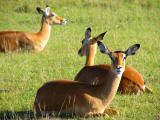
Impala ladies basking in the morning sun
Perhaps you can get an impression of the African morning light from this photo. Unlike the industrialized countries, Kenya has super-clean air outside the cities and when there are no storms carrying dust into the air. This means that the sunrise is not red. Instead the sun rises from the horizon in full, bright glory, something you may never have seen if you've spent all your life in a "developed" country.
I watched various ungulates, meandering through the landscape. There was no other car far and wide, as the two-wheel-drive tourist minibusses didn't dare to drive where it was still wet. Then somebody looked at me from the grass.
It was a lioness, most likely belonging to the pride I had already heard at night. I couldn't spot the others, but they were likely in the bushes, of which you can see a few in the first photo.
Then the hyaenas came with rounded bellies, apparently well-fed from a kill last night. Slowly a whole congregation formed, and they moved as a group with their tails up. I can't say for sure, but this was obviously no hunting endeavor, and it was also not their usual everyday behavior. My best guess is that they formed a temporary border control around their territory. Or they had perhaps seen hyaenas from another clan nearby and signalled vigilance.
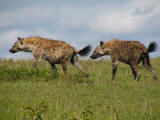
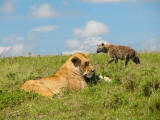
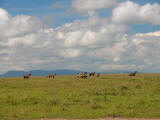
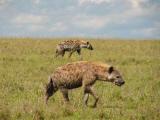
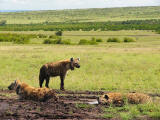
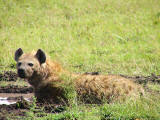
Hyaenas. The second-last photo shows two collared (research) hyaenas.
I moved with the hyaenas for a while, until they settled down and took a mud bath. At one time I was totally surrounded by hyaenas. Obviosly I could not photograph this, would have needed a special surround camera for that, so you never see all the hyaenas in one photo.
Finally, on my way back to the lodge, I met a group of waterbucks. The females were nervous and moved away, but I photographed the buck and then another one who stood nearby.
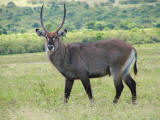
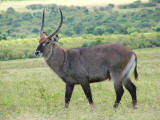


Two waterbuck males, each photographed twice (for the benefit of those who want
to re-use a particular photoask for permission and also ask for the
full-resolution version)
I went out again in the sunny and dry afternoon. When driving past one of the many puddles left over by the last rains, I spotted a carpet of eggs floating on the surface.
I have no idea what kind of animal laid these eggs, but it could have been a frog.
While I looked at the eggs, suddenly a big, black beetle came up to the surface for a split second, obviously to breathe some air, and dived down into the murky water again. While I pondered the thought how long the beetle would need until he had to come to the surface again, another beetle of the same kind appeared nearby. The puddle must be full of these beetles. I wonder what they do when the puddle dries out.
I visited the lioness again. She was still in the same place, but now obviously felt the heat of the afternoon sun. She was breathing rapidly to cool herself down, but, as I have often observed, did not get the idea to move into the shade under a bush. Who knows, perhaps she likes it warm after all.
While driving across the plains, I must have seen 500 topis. One herd I counted at about 300.
The hyaenas were also still there, mostly mud-bathing in puddles. Later I met one with a particularly beautiful leopard-like coloration, and she had no mud crust either.
She? Yes, I guess that from her size. If you want to know more about hyaenas, check this hyaena research report of last year.
That's it for the day. I'm now packing my things for the drive back to Nairobi tomorrow. I'm still very glad the roads are so good now.
Since the night had been dry, I did an early-morning game drive. The morning was very peacefulno big predators visible, no vultures heading for a killeven the lioness was gone, bat that was to be expected, since lions move every night.
When I drove a long way across the grass plains along a temporary creek with bushes, I came into an area where it had rained, and the soil became increasingly wet. Normally I might have continued, but since I still had to reach Nairobi, I couldn't take any chances and turned back.
Among many other herbivores I saw these buffalos:
Then I headed back to the lodge for a good and slightly heavier breakfast than usual, as this would be my only meal for most of the day. Then I packed my bags into the car and drove out.
A hitchhiker stood next to the track, a young Maasai woman in blue jeans, i.e. not in the traditional dress that most Maasai women wear around here, with two little children. I took her with me and found that she spoke unexpectedly good English and was very eager to learn all kinds of things. She wanted to learn more about computers and had already planned to get her own email address. I also explained the GPS, as well as possible with the background.
She asked questions like, "How are data stored in a computer?" or, "What does 'GPS' stand for?" and she tried hard to learn and remember as much and as quickly as possible.
The thought occurred to me that she may have two fundamental problems, living in an agricultural, not very developed part of a developing country:
I think, humankind cannot afford to waste such talent. We are still making grave mistakes. Some people call this the "digital divide", the invisible border between those people who use computer technology and are connected to the Internet and those who don't and aren't.
She stated that she intends to get her own email address. Lorna, if you read this, you've stepped from one side of the "digital divide" to the other.
I arrived in Nairobi at around 16:00, after more than 7 hours. It still takes a long time, in spite of the improved road. At 19:05 I collected my wife (nickname: Mausi) from the international airport, who will join me for the rest of the trip.
For the next three days we swapped the car for an aeroplane, a Cessna 172 (four-cylinder, 160 hp, piston engine, one propeller, four seats, payload with full tanks 260 kg) for a flight to Lamu, an old town on an island at the Kenyan coast.
We had planned to take another passenger, but it turned out that she could not make it, and so just the two of us were going to fly. Mausi is also a trained pilot, and so it seemed quite natural to use this means of transportation.
The day was cloudy, and we waited for the clouds to rise or clear. A short time later we climbed into the aeroplane and taxied to the runway for takeoff. However, during the engine test it turned out that one of the spark plugs didn't ignite. You notice this only during a thorough test, because aeroplanes like this have double ignition systems with two spark plugs in each cylinder. If one spark plug fails, the engine runs normally, but due to the high security standards for flying one doesn't take off with a known defect. So we taxied back to the hangar to let the technicians have a look at it.
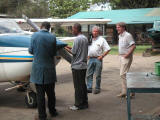
Checking and cleaning the spark plugs
It turned out that one spark plug had collected a bit of coal and needed cleaning. A short time later the engine ran perfectly on either ignition system, and we could take off.
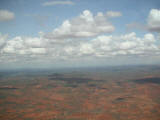

Kenya from above; instrument panel
We navigated past the international airport and out to one of the last outposts of civilization towards the east, Kitui. To ease any potential search-and-rescue operation, we had, just in case, told the aircraft operator that we would fly overhead Kitui airfield and then a precise course straight towards Lamu airfield, based on GPS navigation.
Once past Kitui, human settlements and farms rapidly became scarce, and soon we found ourselves above a seemingly endless thorn bush savannah, structured only with some seasonal rivers, which were all dry. These rivers have no clear beginning or end. They end somewhere in the plains, where their waters form seasonal swamps and ultimately disappear by evaporating into the air or perhaps going into the ground.
In spite of the speed of the aeroplane, crossing these bushy plains takes hours. After more than two hours of flight we reached and crossed Tana River, one of the biggest rivers in Kenya, and were already quite close to our destination, when a band of clouds forced us to fly lower and lower. When we were already down to 1,000 ft (300 m) and the clouds in front of us were still lower everywhere but behind us, we turned back and decided that Lamu was unreachable for us at this time.
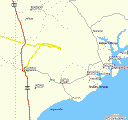
Impenetrable cloud banks, diversion to Garsen
The nearest airfield was at Garsen, a small provincial town near the river, so we turned there. Had we had our planned additional passenger been with us, we might have tried to go to Malindi instead, but my wife and I were both willing to try a remote place like Garsen, and so we flew a low pass over the airfield to have a good look at it.
The field looked good, but the center of the runway doubled as a road and had small bushes on either side that made the usable runway smaller than the original runway had been. I could spot only one bush half-way down the runway though that would touch our high wings, and so I landed short and stopped the aeroplane well before that bush, then taxied carefully past it on the way to a suitable parking place for the aeroplane.
Garsen is a small, quite remote town, but its inhabitants were very friendly and helpful. A passing tuk-tuk (a three-wheeled mini-taxi originally invented in India) took us along the nearby road into the town and to a small "Caritas Guest House", which turned out to be just acceptable for an overnight stay.
When we walked in, we found three men in the temple-like court, chewing mirraa (khat). One of them was the attendant. He showed us a room, told us the price (KSh700 ~ €8) and brought a second bed and a second mosquito net, which he tied to nails in the ceiling.
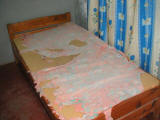

Bed and mattress; happy hotel guest
Don't worry, we did get an additional fine bedsheet over the one you can see above. The guest house was no five-star hotel, but it had the essentials and didn't have any severe problems. Well, the toilet could have had a seat, but we survived.
After settling in we went for a stroll along the short main street of Garsen and had a plate of goat meat and ugali (maize meal, boiled in water) that was much better than we thought it would be and tasted better than some much more expensive lodge dinners.
Finally, already after dark, which we had tried to avoid, but couldn't, because the food was prepared in "African time", we walked back to the guest house and went to sleep, not before discovering a few of the finer details.
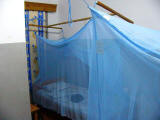

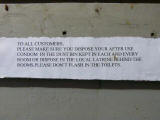
Mosquito nets and bathroom of the "Caritas Guest House"; interesting notice
The notice on the door indicates that they also charge by the hour, which is not very unusual for the small "hoteli".
When I moved a bit under my mosquito net, it fell down, because one of the string knots had failed. The wooden frame woke me up unpleasantly. Nothing is perfect, not even a guest house bed in Garsen.
The next morning we looked at the weather, which seemed much better for our flight, then we went to the main street again and had breakfast in the "Happy Family Restaurant", a small open-air place that offered some good chai and other things like mandazis. Since there are no tourists in this town (except us), we ate what the locals eat, and it was quite good.
After our small breakfast we set out to find a tuk-tuk that we could rent for an hour and soon found one whose driver had his friend with him. We went to the Garsen Police Station to check whether we could get them to do something about the bushes on the airstrip, but the man on duty didn't seem interested in anything like that at all.
Next we asked our driver and his friend where we could find some workers who are able and equipped to cut down bushes on the airfield. But they immediately said, we can do that ourselves, and drove off to get pangas (the Kenyan word for machete).
Equipped with the proper tools, we returned to the airfield and set out to work on the bushes. We drove along the airstrip, I pointed out every bush that was high enough to touch our wings, and the bushes were cut off at the top. My enthusiasm did not go far enough to cut off all bushes entirely to make the airfield suitable for low-wing aircraft. I made a mental mark of the fact that high-wing aircraft have a significant advantage in situations like this.
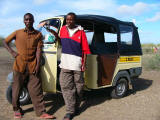
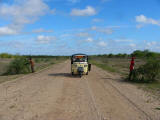
Marega Kofa Felix and Godwin Gonnah; cutting the bushes
After all the oversized bushes were cut, we paid our two diligent workers, instructed them when and how to stop all oncoming cars, fired up our engine, rolled down the renovated runway, and took off.
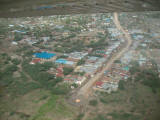
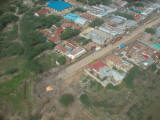
Garsen; the end of the Garsen main street
The left photo above shows Garsen (under our wing). Our guest house is barely visible at the far end between the bigger red and white tower and a church with a blue roof to the right of it. The restaurants are more in the foreground, in the middle of the town.
The weather enroute turned out to be not much better than the day before, but it was good enough to get through to Lamu. The cloud base was no lower than 1,200 ft, so we happily flew straight to Lamu, did a low pass over the runway, which is paved and in good condition, flew a circuit over Lamu town, and finally landed.
A boat takes us across the 1 km wide strait between Manda and Lamu islands.
We move into Petley's Inn, perhaps the oldest hotel in town, which was originally built around 1930 and completely rebuilt by Mulji Ratna around 1960.
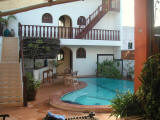
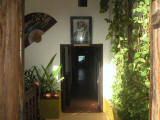
Petley's Inn, swimming pool in the first floor; entrance to guest rooms
The receptionist promises to give us the best rooms early in the afternoon, provided we are patient enough to wait until then. We agree and stroll through the medieval-looking town with its very narrow streets, far too narrow to allow the passage of a car. Pictures from the German Postal Service Museum:
Strolling through Lamu is fascinating, because one becomes part of the everyday life of the town's inhabitants. There are small shops, workshops, and plenty of places to sit down and just watch.
After some time had passed, we returned to Petley's Inn and were rewarded with their best rooms, including air conditioning, which is very pleasant in a climate as warm and moist as Lamu's at around 30C day and night. We didn't have the air conditioning on during the night, but when we walked out, we switched it on to be able to cool down when we returned.
We met the manager of the sister hotel of Petley's Inn, the New Palace Hotel, which was built much more recently and may be the best and most modern hotel of Lamu, and she showed us around the house.
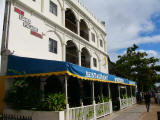
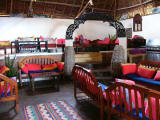

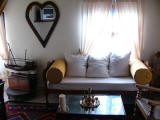

New Palace Hotel exterior and interior
For me it is a pity that we didn't have the full day in Lamu that we had originally planned, because I perceive Lamu and its inhabitants as very photogenic and would have loved to take more photographs. But the time was running, and after a wonderful dinner with lobster for Mausi and a grilled Red Snapper for me we sank into the bed to the sounds of the town's night life.
The next morning we had breakfast over in the New Palace Hotel, while we looked critically at the weather for our flight back to Nairobi. After a line of clouds had passed, we got a clear blue sky with the next cloud front already visible over the ocean, so we slowly got going, took our things, and moved to the pier to set over to Manda Island and the airfield. A short time later we were in the air again.
We flew out to the ocean shore to take a few photos of Shela, a smaller town on the ocean side of Lamu Island.
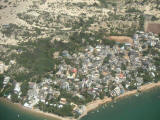
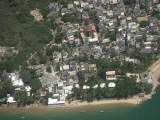
Shela, a smaller town at the ocean shore
We took a final look back at Lamu airfield, then we set course for Kitui.
The flight over Kitui and on to Nairobi was nice and uneventful. We arrived back in the Aero Club of East Africa in good shape and settled into our room after handing the aeroplane back to its operator.
Some days were needed in Nairobi.
Today I made a flight into the Rift Valley, taking a few photos along the way. The first three show places inside Lake Nakuru National Park.
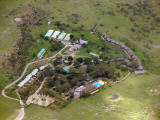
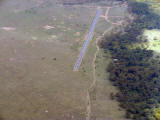
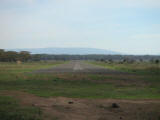
Lake Nakuru Lodge; Naishi airfield from the air and from the ground (taken
later)
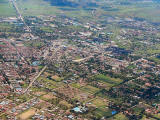
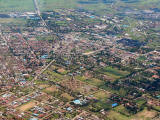
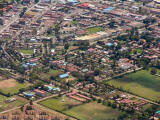
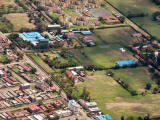
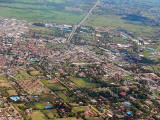
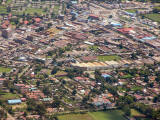
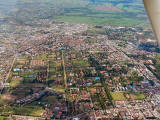
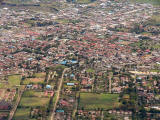
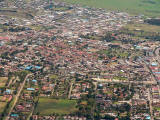
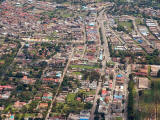
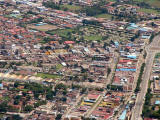
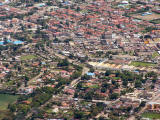
Nakuru town, all photos taken during a flyby on the eastern side
Some more photos of the Mogotio petrol station and of Loruk can be seen in the travel report below, in line with us passing these points.
Loruk is the place where one has to turn off to the right to drive towards Tangulbei, Churo, Mugie, Sukuta lol Marmar, Kisima, Maralal, Lodungokwe, Wamba, and finally the nature reserves in Samburu land.
We had now got everything settled in Nairobi and could set out for Nakuru. The drive was uneventfulthe roads were good, and we reached Lake Nakuru Lodge in the afternoon.
The lodge was as good as ever. We met the owner, whom I had met before, and gave him the aerial photo of his lodge.
In the evening we drove around the nature reserve a bit, then had the usual good dinner and went to bed, from which we had a view over the lake.
In the morning we had a long drive after breakfast to Makalia Falls, which had only very little water, but still has a nice campsite. We admired the flamingos in the lake and many other animals in the nature reserve, among others the rhinos.
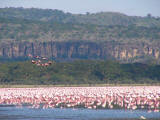

Flamingos in Lake Nakuru; Rothschild giraffe
Eventually we left the nature reserve and drove into the town, where I could take the following photo.
We spent the afternoon and evening with friends in Nakuru town and went to a hotel there for the night.
In the morning we went to an ATM to get money and to some shops to get a large amount of milk for a baby Grevy zebra that had apparently lost its mother to a disease and was now kept near Samburu West Gate.
Then we searched and found a car electrician, because something was wrong with all the rear lights. When we blinked on the left side and stepped on the brake, all rear lights blinked. Just blinking left did not work, at least not on the rear end.
We drove to a garage, and the people there could not do it, but they knew an electrician, who was very good and analyzed and solved the problem perfectly. After a short discussion with the garage people they asked for a price that I estimate as the geometric average between the normal Kenyan price and the normal European price. We signalled that we understood this kind of pricing, but we paid without any further negotiations.
The man on the left side in the second picture is the electrician, so if you ever need one in Nakuru, call Andrew Otieno at +254 711 428795.
Then we left Nakuru and drove north towards Mogotio, Marigat, and Baringo. Mogotio has the last reliable petrol station along the first part of our northern route, so it is an important one that one doesn't want to miss. Of course we filled the tank there.
On the way I couldn't help taking the following photo, which struck me as funny because of the misspelling of the word "excel".
This made me think again about the subject that had touched me already before, the value of education and good information for people living in remote places in a developing country.
We arrived in Baringo in the afternoon and visited the Bashir family, whom we have known for a long time.
Although we had thought of going to Roberts Farm for the night, we changed our minds and went to the Lake Baringo Club instead, a lodge, actually the only one, at the shore of the lake.
The lodge was partly decaying, probably due to little tourism for the last two years, but the cook was one of the best we could remember, so we could enjoy the food.
In the evening we visited more friends, the people who run RAE Trust, and exchanged information on the project and other topics.
The next morning Mausi took 11-year-old Sakia to the swimming pool to give her a swimming lesson. She did well and probably lost some fear of water. Of course an hour or two are not enough to turn her into the perfect swimmer, but she certainly enjoyed it.
After lunch we drove away. Not far north along Lake Baringo we have to turn off at this important branch, named Loruk for the little village there.
Here one has to turn right to reach Tangulbei, Churo, Mugie, Sukuta lol Marmar, and Kisima. In Kisima we continued north to Maralal and the Yare Camel Club. The not quite 15 km from Kisima to the club take between 45 min and one hour.
The Yare Camel Club was built and run by Malcolm Gascoigne and was quite famous in its best days, but today it is, unfortunately, decaying. Our toilet did not flush properly, and the warm-water tap of the washing basin rotated purposelessly around the axle, so we could not actually open the tap. At least the shower worked.
The bar and restaurant worked, however, and so we could have some food and a good night's sleep.
After breakfast we drove back south to Kisima again, then turned east towards Lodungokwe and Wamba.
The landscape was magnificent, but dry. The last three years had brought less than the usual amount of rain, and the land had turned even more into a semi-desert than usual.
The road had deteriorated over the last two years since I had last driven here, and the distance I used to drive in about three hours now took 4. We turned to the right before Wamba, then again at the turnoff towards Samburu West Gate.
We took the already mentioned milk to the place where the baby Grevy zebra lived.
Finally we drove into the nature reserve and reached our lodge not long before sunset.
The first impression we got of the Samburu and Buffalo Springs nature reserves was that there was very little wildlife, hardly any green grass, in spite of the rainy season, and much of the dry grass was already eaten. People told us that until a week ago the reserves had been full of Samburu cattle that ate all the grass. Then there had been a major operation by the rangers to drive all cattle out of the reserves in preparation for the tourist season.
Of course this is little consolation, because the wild animals were already hit by the drought and had now taken a double hit by the cows eating the little grass that was left. In Kenya, wildlife is the last thing anybody seems to care about. As long as a few wild animals are left for the tourists to see, there is hardly any attempt at nature conservation.
We drove inland from the river a few times, but the area was mostly devoid of large animals. The only few we could find were usually near the river, which still carried a little bit of water.

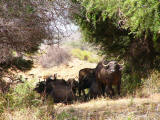
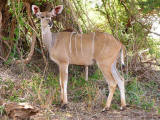
Hare; buffalos; female Greater Kudu

Vervet monkeys taking over the car
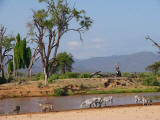
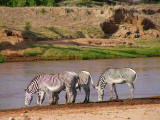
Waterbucks and Grevy zebras drinking from the river
Last night a lioness got shot in the middle of the nature reserve, directly across the river from Larsen's tented lodge. She was shot in the forehead at close range. The drivers thought it obvious that she was shot by Samburu herders who had taken their cattle deep into the Buffalo Springs reserve at night. They didn't tell the tourists. When a tourist asked, the drivers mumbled something about a disease, because they thought it too embarrassing that anybody would shoot a lion in the center of the nature reserve.
When we heard about it and saw the carcass the next afternoon, it was already in a state of decomposition. The rangers had been there and put a few pieces of wood on the carcass.
The lioness had 4 cubs. Several people, including us, searched for the cubs that day, until finally the same driver who had found the lioness found the cubs as well. A few photos from the next day:
The lion cubs were moving and playing in the morning and in the evening and hid in a thick bush during the day. A few people protected them during the day by blocking access, to prevent that a chain of noisy tourists would chase them deeper into impenetrable bushland.
The rest of the pride appeared in a place nearby, but even if they had found the cubs, since another lioness would not let them suckle, that was of no help to them.
Since the cubs still depended on their mother's milk, they would not survive in the wild. Therefore an operation was started to let a veterinary catch them and take them to an orphanage. In my view that is not a big consolation, as life in a wild animals orphanage is not very enticing.
The worst is that this single lion kill has reduced the entire lion population of the Samburu and Buffalo Springs nature reserves from an estimated 20 to 15.
These are photos to document how we could check our email and upload this web page from the bush in spite of having no mobile phone network coverage in the lodges down by the river.
Between computer and mobile phone there is a Bluetooth connection.
In the morning after breakfast we met the car of the veterinarian at the lodge's petrol station, who had come to catch the lion cubs. We later heard that the operation took a full 12 hours, from sunrise to sunset, and was done by darting each of the cubs, who were hiding in thick bush. Particularly the youngest cub was very scared and hid so deep in the bush that it took much of the time until he was finally caught.
While the cubs were caught, we had already left Samburu Lodge and drove east towards Archer's Post. We did not take the shortcut to the Isiolo Road, because we had been told that Isiolo Road has been renewed and is now very nice.
So we used the morning for a last game drive across the eastern part of the nature reserve and found a small herd of oryx antelopes.
Eventually we drove through Archer's Gate and reached Archer's Post soon thereafter. Along the way we met a herd of camels and their Samburu herders.
Isiolo Road was not quite finished, so we had to drive through a number of diversions, but a large part of it was indeed redone and in very good condition.
We picked up two road workers, a man and a woman, who helped us navigate the signs. For example, there was a "stop, no entry" sign in front of the longest semi-finished part of the road, but the road workers told us, the sign is a mistake, we should just use the road anyway. That was quite helpful, because a good German would never ignore such a sign. It saved us a lot of time and nerves.
The slender, polite, and beautiful woman turned out to be the operator of one of the big bitumen machines used to produce the surface material for the new road. I would never have guessed that.
After the long drive we arrived in Nairobi in good shape and spent our last night in the Aero Club of East Africa.
The flight was operated by Kenya Airways. They now also have an Internet check-in where one can choose the seat, which we had done yesterday evening.
They also still had the same entertainment system mentioned in previous reports with a very good selection of about 10 movies. We arrived in Munich early and in good shape.
If in this text you find any typos, orthographic errors (even small ones), ungrammatical sentences, wrong or illogical information (like wrong names of birds), if you want me to write more details about something in particular, or if you want one of the photos in full resolution (usually 1,600 x 1,200 pixels), please click on the email sign below and write to me. Many thanks!
Copyright 2009-2023 Hans-Georg Michna.
Private homepage – Hans-Georg Michna
Kenya travel reports: 1999, 2000, 2002, 2003, 2004, 2005, 2006, 2007, 2008, 2009, 2010, 2011, 2012, 2013-Goma, 2013, 2014, 2015, 2016, 2017, 2018, 2019
Kenya Safari Travel Plan, Kenya 1980-2000 photos
hits since 2009-04-01
Free PHP scripts by PHPJunkYard.com